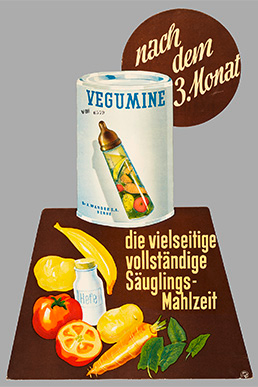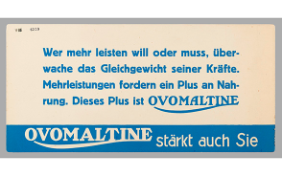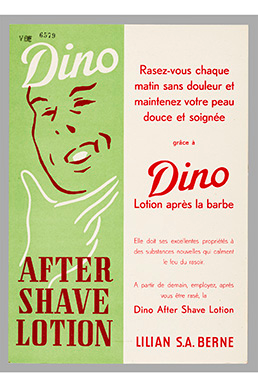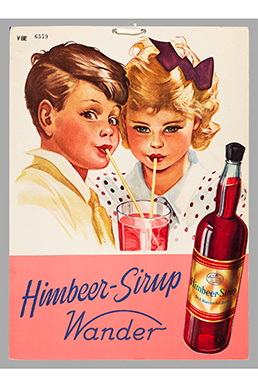An old box of cardboard advertising panels from the company Dr. Wander AG was long forgotten until its recent discovery, which has shed light on marketing messages from the first half of the 20th century. This collection of well-preserved visual merchandising material includes ads for Wander’s hit products – such as Ovomaltine – in addition to pharmaceutical products and cosmetics that the company developed after its founding in 1865.
By Fabia Hiltbrunner
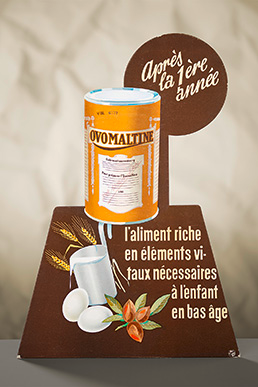
ca. 1930s (unknown)
Sixty cardboard advertising panels were recently discovered in the National Library’s General Collection and are now being rehomed in the Prints and Drawings Department. The ads resemble posters but are made of cardboard; measuring at around 30 cm x 45, they are also much smaller than a conventional poster. These panels were probably used inside shops or placed in shop windows next to the product in question.
A standout example is the ad for Ovomaltine, which was invented 120 years ago. The shape of the panel is unusual: it is not rectangular, but is instead cut to follow the shape of the Ovomaltine can protruding from the top, which is almost the same size as the bottom half of the panel. The ad highlights the individual ingredients of the beverage and includes a snappy message promoting it for young children. Potential customers got a quick overview of what was in Ovomaltine: grains, milk, eggs and cocoa. Taken together with the text, the message is clear: Ovomaltine is healthy and can contribute to the healthy lifestyle of children as young as one year old.
Ovomaltine was invented in Bern in 1904. Looking back at the 120-year history of the chocolate malt extract beverage makes it clear that Wander AG’s marketing messages were clearly a hit. Ovomaltine’s ad campaigns originally focused on its benefits as a dietary supplement, and the beverage was only sold in pharmacies and drugstores. It only began being sold in normal retail stores after 1922.
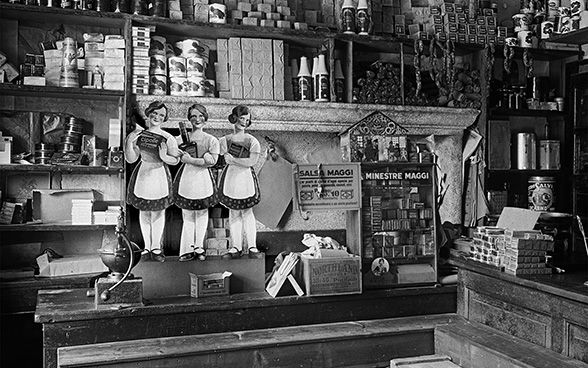
In the early 1920s, Ovomaltine’s ads were targeted at an upper-middle class audience. However, the potential customer base was soon expanded to all social classes, with the messaging of the ads adapted accordingly. Interestingly, the unearthed ad collection contains an entire series of ads with the same design. There are also ads for Veguva, Lacto-Veguva, Vegumine and Nutromalt, creating a brand recognition effect for Wander products. Unfortunately there are hardly any clues as to who designed these ads, with only occasional small mentions of the printer (the initials “LC” between two printing rollers).
Marketing messages: short and sweet
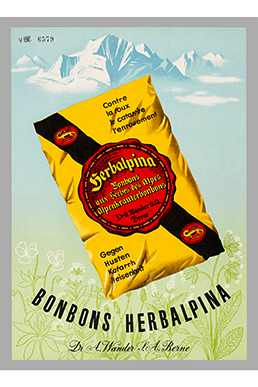
candies, ca. 1950 (unknown)
The advertising panel for Herbalpina hard candy features the packaging floating over a blooming field with the impressive Jungfrau peak in the background. Herbalpina, which could be taken for coughing, mucous build-up and sore throat, is embedded in this idealised mountain landscape, with alpine herbs and mountains creating a direct link to the candy’s ingredients.
Wander AG’s pharmaceutical product portfolio is relatively unknown today – for instance, a pain and rheumatism reliever called Alcacyl that was produced starting in 1927.
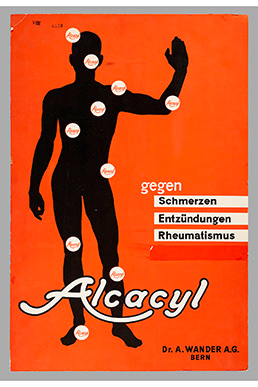
medication, ca. 1930s (unknown)
The ad for Alcacyl features a highly minimalist design, with a black figure on a reddish orange background. Alcacyl “points” show the different parts of the body where the medicine can take effect, accompanied by text – “against pain, inflammation and rheumatism” – in a small font size. This design has a strong brand recognition effect: the vibrant red-orange background and the black silhouette are unmistakable, and the consumer can make a clear connection to the packaging, which featured the same colour scheme.
The company had a large product palette, so the styles of their advertising panels were rather diverse. The panels took their design inspiration from posters: eye-catching combinations of images and text that quickly convey information to a large target audience. However, the smaller and sturdier format of the panels was tailored for being presented in other locations – one small piece of an overall marketing mix that consisted of various promotional strategies (ads, posters, packaging, etc).
Wander AG, founded in 1865 and headquartered in Bern, is a manufacturer of specialised food and pharmaceutical products. They enjoyed great success with their malt extracts, first marketed in 1903 as Maltosan and then in 1904 as Ovomaltine. The company expanded internationally and merged with Sandoz AG in 1967. Today it belongs to Associated British Foods. Since 2006, all of the company’s European production of nutritonal products – including Ovomaltine – has been located in Neuenegg (BE). (Source: Walter Thut, “Vom Zwei-Mann-Labor zum Weltkonzern”)
The 60-piece advertising panel collection from Wander AG will be catalogued over the course of 2024 and integrated into the HelveticArchives database.
Bibliography and sources
- Walter Thut: Vom Zwei-Mann-Labor zum Weltkonzern: Georg Wander (1841-1897), Albert Wander (1867-1950), Georg Wander (1898-1969). Meilen: Verein für Wirtschaftshistorische Studien, 2005.
- Hans Rudolf Schmid: Hundert Jahre Forschen und Wirken 1865-1965: Jubiläumsschrift zur Hundertjahrfeier der Dr. A. Wander AG Bern. Bern, 1965.
- Margreth Schädeli: “Mach’s au so! Trink Ovo …”: die gesellschaftliche, wirtschaftliche und politische Geschichte der Schweiz im Spiegel der Plakatwerbung von Ovomaltine 1940–2012. Bern: Bern Open Publishing, 2021.
Last modification 25.01.2024
Contact
Swiss National Library
Prints and Drawings Department
Hallwylstrasse 15
3003
Bern
Switzerland
Phone
+41 58 462 89 71





